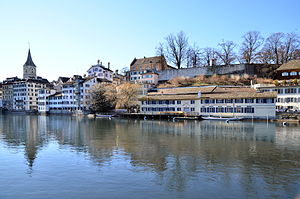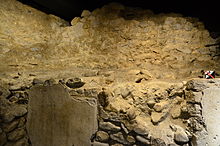 Lindenhof hill, Schipfe and the Roman wall of the later Pfalz fortifications, as seen from Limmatquai, Weinplatz to the left | |
| Alternative name | Turegum, Turico |
|---|---|
| Location | Lindenhof–Sihlbühl–Münsterhof-Weinplatz-Limmatquai |
| Region | former Germania Superior, present city of Zürich, Canton of Zürich, Switzerland |
| Coordinates | 47°22′22″N 8°32′26″E / 47.37278°N 8.54056°E |
| Type | Vicus |
| Part of | Lindenhof hill respectively Oppidum Zürich-Lindenhof |
| Length | about 500 metres (1,640 ft) Sihlbühl–Bürkliplatz, Grosser Hafner island excluded |
| Width | about 200 metres (656 ft) Augustinergasse–Limmatquai |
| History | |
| Material | stone and wood |
| Founded | Probably around 15 BC |
| Abandoned | Around 401 AD by the Roman army, settlement continued by Gallo-Roman inhabitants |
| Periods | Roman Republic to Roman Empire |
| Cultures | Helvetii and Gallo-Roman |
| Site notes | |
| Excavation dates | 1906, 1937, 1989, 1997, 1998-2001, 2004, 2007, 2008 and 2014 at Lindenhof hill, Münsterhof, Weinplatz (Thermengasse), Rennweg, Augustinergasse, St. Peterhofstatt, Münzplatz, Schipfe (Limmat) and Grosser Hafner |
| Archaeologists | Margrit Balmer, Dölf Wild |
| Condition | aeaorchological access |
| Ownership | City of Zürich |
| Management | City of Zürich |
| Public access | Thermengasse and so-called Lindenhofkeller showing the Celtii, Gallo-Roman and Carolinum walls.[1][2] |
Turicum was a Gallo-Roman settlement at the lower end of Lake Zurich, and precursor of the city of Zürich. It was situated within the Roman province of Germania Superior) and near the border to the province of Raetia; there was a tax-collecting point for goods traffic on the waterway Walensee–Obersee-Zürichsee–Limmat–Aare–Rhine.


- ^ Access by personal demand at Baugeschichtliches Archiv der Stadt Zürich at the Grimmenturm building, Neumarkt (Zürich).
- ^ "Baugeschichtliches Archiv" (in German). Hochbaudepartement der Stadt Zürich. Retrieved 2015-08-21.
